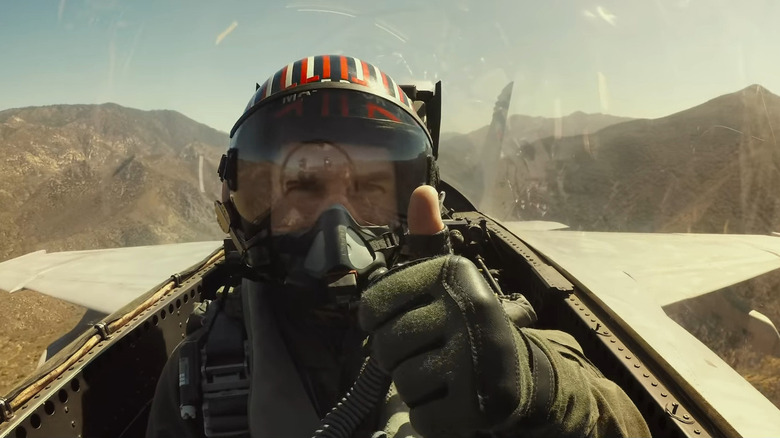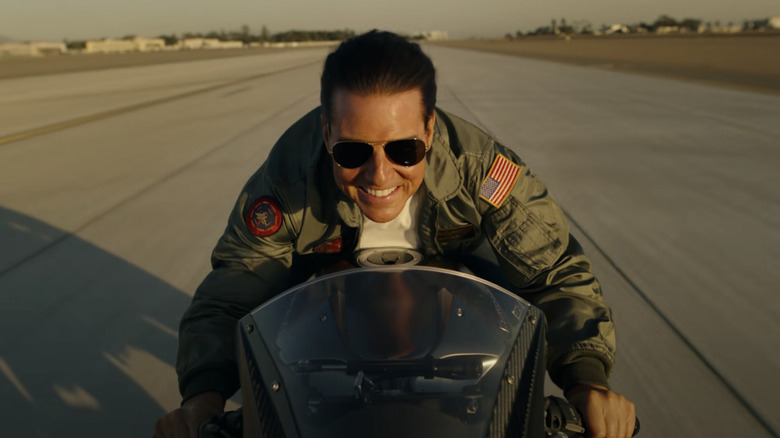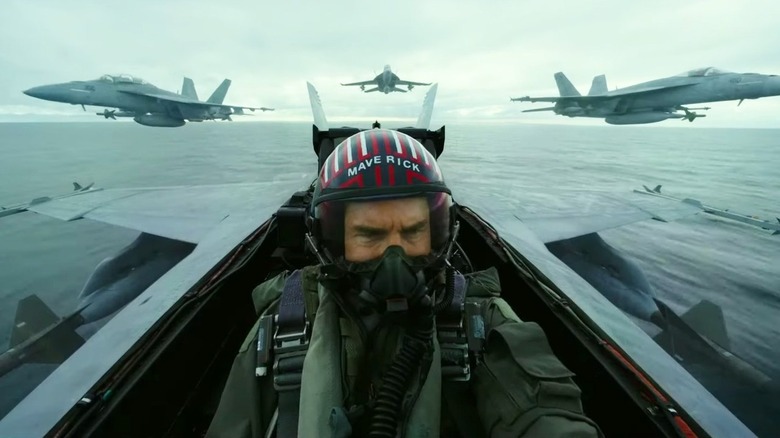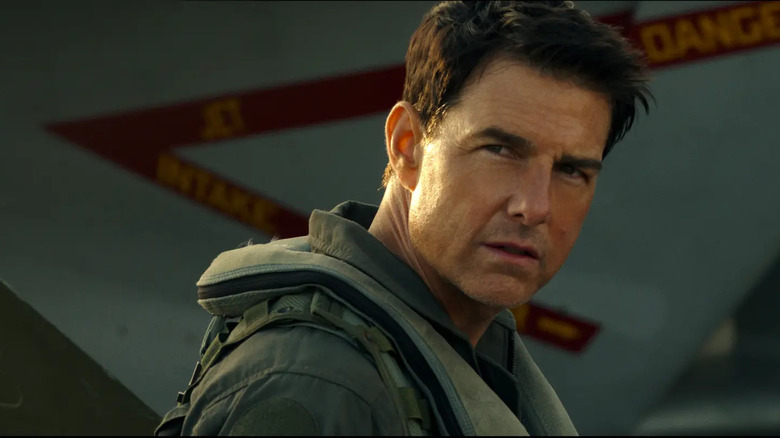Top Gun: Maverick Takes The Legacy Sequel Concept To The Danger Zone
Legacy sequels, or legasequels as they've come to be called by some, are what keep the wheels on the Hollywood machine going round. They are an extremely lucrative concept that allows for decades-old movies to be brought back with some of the original cast for nostalgia purposes, before passing the torch to a new generation that will hopefully prove lucrative enough to carry on the franchise for years to come. It's a phenomenon so established by now that it became the core subject of the new "Scream."
The latest legasequel to make it big at the box office is "Top Gun: Maverick," a follow-up to the 1986 megahit about how cool planes, aviator sunglasses, bomber jackets, volleyball, dudes, the navy, planes, and bros really are. "Maverick" clearly plays with the tropes of the legasequel, from an ensemble cast of fresh would-be A-listers, to cameos from characters from the original, to the entire opening scene replicating the one from the 1986 original. And yet, the film does something different: it reveals itself to be not just a movie about Tom Cruise teaching the next generation, but a movie where Tom Cruise teaches the next generation that only he can be trusted to get the job done.
Spoilers for "Top Gun: Maverick" ahead!
A man out of time
In "Top Gun: Maverick," we see Pete "Maverick" Mitchell refusing to accept a changing world and eventually punished into returning to where it all started: the Top Gun program. There, he's tasked with training new pilots for a suicide mission that is essentially the trench run from the original "Star Wars." In many ways, Mitchell has turned into the epitome of a dad movie character, an old man who refuses to accept that things are different, and is proven right by the end — also the same character Clint Eastwood has played for the past few decades.
It is also ostensively a movie about Tom Cruise himself, the last bastion of a long-gone era of filmmaking — of a time where movies didn't need to be filled with CG effects, the cast needed one or two stars, not 10, and where the big set pieces involved practical stunts. While at Cannes this past month, Cruise gave a talk celebrating his career where he essentially spent an hour putting himself up on a pedestal, talking about how he learns what everyone's job on a set is and makes sure every single worker feels like part of the team.
Though very gratuitous, it makes sense that Cruise would be so dedicated to making Maverick the kind of guy who wants to make sure everyone in his crew feels essential, and who fights the good fight against a changing industry.
Star Wars on Earth
This is not entirely dissimilar to how Harrison Ford's Han Solo acted in "The Force Awakens." When we first are reunited with Han, he is an old man desperately trying to hold onto a life he gave up decades ago, still hanging with his best friend doing odd jobs while dreaming of getting his old car back. Like Maverick, Solo also ends up with young protegees he tries to teach to, before sacrificing himself to ensure the new generation has a fighting chance.
And yet, what makes "Top Gun: Maverick" unique and different is that Maverick doesn't die at the end, he doesn't pass the torch. Hell, he doesn't even stay on the ground giving instructions.
Instead, he is always the lead character, all the way to the third act where he is asked to lead the trench run himself after proving he is the only person capable of bulls-eyeing womp rats not much bigger than two meters. Indeed, if it wasn't clear enough before, producer Jerry Bruckheimer finally fulfilled his dream of making "'Star Wars' on Earth," with a plan that boils down to hitting an exhaustion port with a bomb and causing a chain reaction that blows up the Death Star. But if that's the case, "Top Gun: Maverick" ends not with Luke as the hero, but with old Ben Kenobi delivering the final shot.
I feel the need
This interrogates the idea of the legasequel and their forced passing of the torch. Though the idea of a legasequel is to avoid the curse of the sequel that tarnishes the original by having the original characters show up but not enough that audiences question if it ruins the ending of the original, the problem is that legasequels are built on the nostalgia of seeing these characters. If all you care about in a "Top Gun" sequel is seeing Tom Cruise as Maverick, why would you care about a movie starring a bunch of new kids?
Tom Cruise understands this, and for an actor who has singlehandedly kept the star-driven blockbuster of old alive and thriving, it makes perfect sense he would reject the idea of making a sequel solely so that he'd hand things off to a new cast. Instead, he made a movie that celebrates his star power and proves he, like Maverick, is right in thinking they can still carry a movie by themselves. Now the question remains, what would Tom Cruise's version of "The Empire Strikes Back" look like with Ben Kenobi as the lead character?
"Top Gun: Maverick" is in theaters now.



